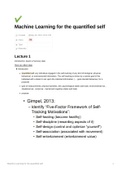✔
Machine Learning for the quantified self
Created @May 30, 2021 10:31 PM
Class S6
Type
Materials
Lecture 1
Introduction, basics of sensory data
Here we collect data
introduction
Quantified self: any individual engaged in the self-tracking of any kind of biological, physical,
behavioral, or environmental information. The self-tracking is driven by a certain goal of the
individual with a desire to act upon the collected information. (→ goal oriented behaviour, for a
purpose)
type of measurements; physical activities, diet, psychological states and traits, environmental var.,
situational var., social var., mental and cognitive states and traits
purpose:
Machine Learning for the quantified self 1
, Machine learning
= automatically identify patterns from data
difference from other ML
sensory noise: we suffer from this, sometimes disabled, noisy, need good ways to
revenue this
missing measurements: also related to the noise, what do we do with large missing gaps
temporal data: order is in benefit, someone becomes better. temporal dimension is thus
important
interaction with user
learn over multiple datasets: people have different devices and different characteristics
how are you gonna learn over them
basic definitions and notation
we do measurements, this is one value for an attribute recorded ta a specific time point: heart
rate, activity level, speed, facebook post, activity type
ML terminology
supervised learning: ml task of inferring a function from a set of labeled training data
unsupervised learning: no target measurement (or label), you need to describe the
associations and patterns among the attributes
reinforcement learning: trying to find optimal actions in a given situation so as to maximize a
numerical reward that does not immediately come with the action but later in time
Mathematical notations:
variables for the features
Machine Learning for the quantified self 2
, the last x is small, Xit the t is indicating temporary variables
variables for the targets
mostly only one target, so k=1
and if the G has a hat: ∧ it means it is predicted target value. The G if we have categorical
prediction, and Y if we have numerical predictions
Example:
Machine Learning for the quantified self 3
, For the combination of all the given data from all sensor combined we need some
preprocessing....
most important parts is the preprocessing and identification of useful features → do machine
learning and use the valuable ML insights to have a feedback loop
sensory data
introduction to case study and basics of handling sensory data
We have different tables for different sensors. We need to combine these tables.
1. Select step size Δt you want to consider in the data
size depends on the situation
Machine Learning for the quantified self 4





